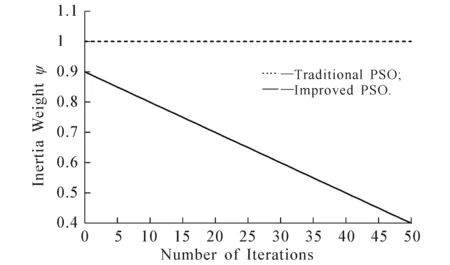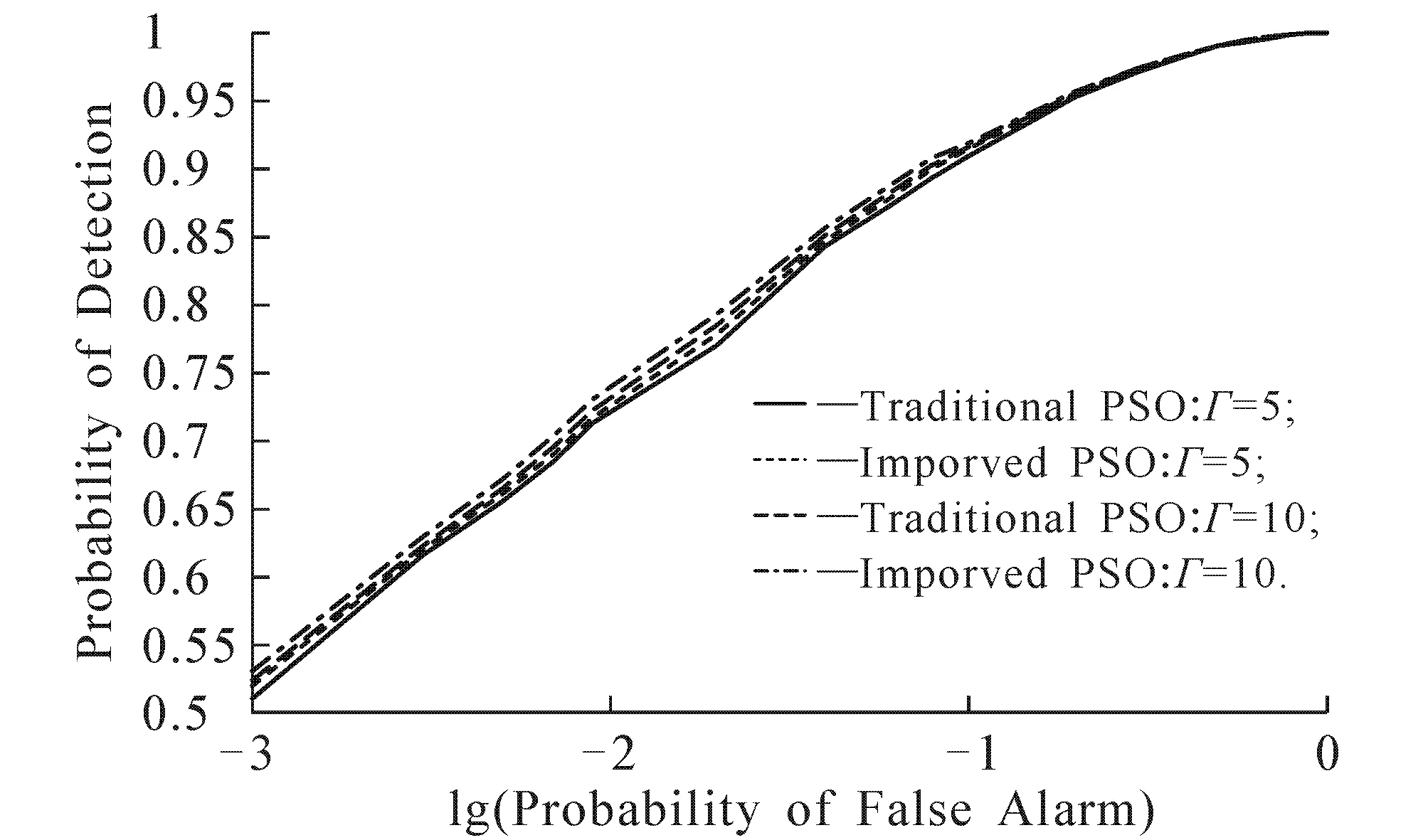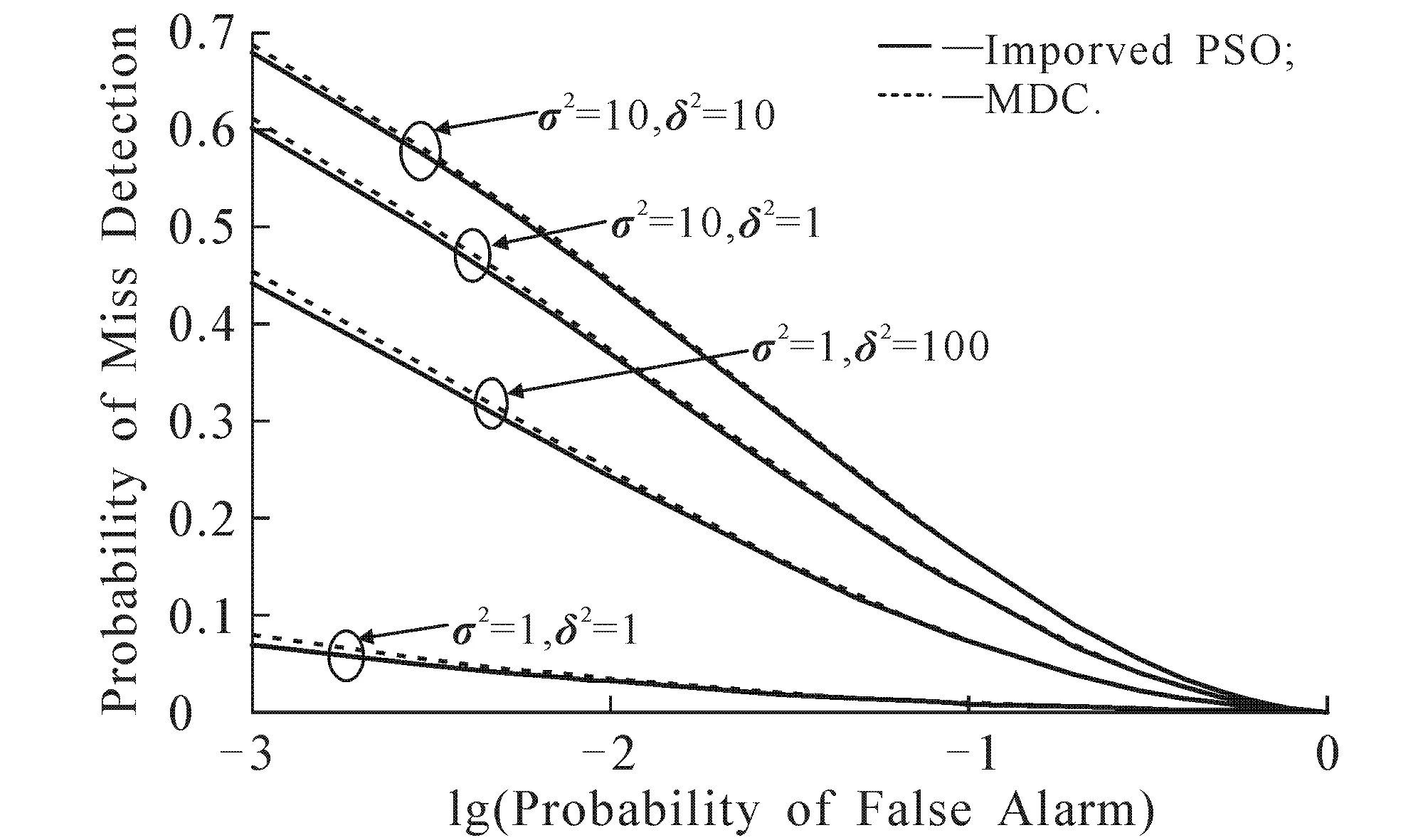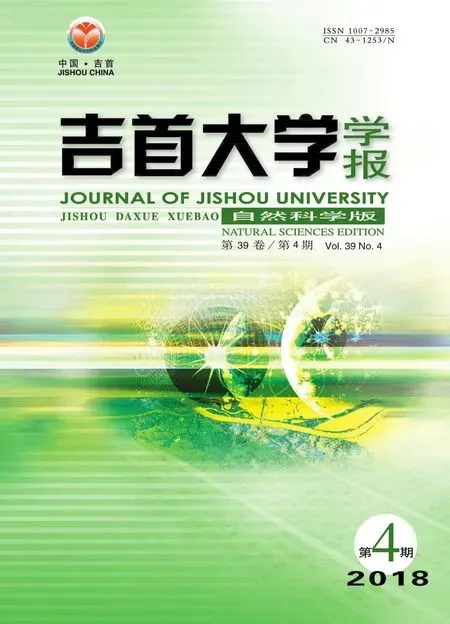Fast Cooperative Spectrum Sensing Method Based on Improved Particle Swarm Optimization*
2018-09-12LIUYaofengDENGYuSHUTingLEIKejun
LIU Yaofeng,DENG Yu,SHU Ting,LEI Kejun
(College of Information Science and Engineering,Jishou University,Jishou 416000,Hunan China)
Abstract:To improve the computation efficiency and the sensing performance,a new linear cooperative spectrum sensing algorithm is developed for cognitive radio.In the proposed method,the improved particle swarm optimization (PSO) is utilized to obtain the optimal weight vector to maximize the probability of detection by dynamically changing the inertia weight in each iteration.Due to using the of time varying inertia weight,the proposed PSO based cooperative spectrum sensing algorithm has good global exploration capability at the beginning of the swarm flight,and with the increase in the number of iterations,especially in the late swarm flight,has good local search capability.The simulation results illustrate that the proposed method has faster convergence speed than the method based on the traditional PSO.At the same time,it shows better detection performance than both the method based on modified deflection coefficient and the method based on traditional PSO.The simulation results under different sensing scenarios validate the effectiveness of the proposed cooperative sensing algorithm.
Key words:cognitive radio;cooperative spectrum sensing;particle swarm optimization;energy detection;modified deflection coefficient
Cognitive radio (CR) has been considered as one of the most potential technologies to improve the spectrum efficiency in wireless communications.The core idea of cognitive radio lies in that the secondary users are allowed to access the spectrum holes when the primary users are absent.To achieve this goal,the secondary users must continually execute spectrum sensing.Once the secondary users reliably detect the presence of the primary users,they have to vacate the corresponding channel immediately[1-2].However,in practical applications,it is really hard to reliably detect the presence of the primary users due to deep fading or shadowing conditions.
To improve the detection reliability of spectrum sensing,the cooperative spectrum sensing algorithms have attracted a lot of attention[3-9].The AND fusion criteria and OR fusion criteria have been used to combine local decision results from several secondary users scattered in different locations[5-6].In Ref. [7-8],a linear cooperation spectrum sensing method was exhibited,in which a modified deflection coefficient (MDC) based method has been used to search the cooperation coefficients.Note that the MDC-based method is suboptimal due to the non-convexity of the optimal cooperation problem in nature,which eventually results in performance degradation in practical spectrum sensing applications.In view of this,a cooperative spectrum sensing scheme based on the intelligent optimization method has been proposed[9],in which the global optimal cooperative vector is searched via the traditional particle swarm optimization (PSO).However,its slow convergence becomes one of the main problems in practical applications.In this paper,by maximizing the probability of detection,a new cooperative spectrum sensing algorithm based on the improved PSO is presented by changing the inertia weight dynamically in each iteration,which fastens the convergence rate and enhances the detection performance.
1 System Model


Fig. 1 Linear Cooperative Spectrum Sensing Model

The fusion center calculates the test statistic from thel-th secondary user marked asfl=yl+vl,wherevlrepresents the channel noises.According to the results of Ref. [7],flis normally distributed with means and variances respectively defined as

(1)
Obviously,the values ofPfandPdrely heavily on the weight matrixwand the thresholdγc.Once the targetPfis given,the threshold at the fusion center can be obtained directly from Eq. (1) as
Thus the probability of detection correspondingly becomes
(2)
2 Proposed Fast Cooperative Spectrum Sensing Algorithm
The objective of the linear cooperative spectrum sensing is to maximize the probability of detectionPdwhile meeting the requirement of spectrum utilization.In order to maximize Eq. (2),we need to find the optimal weight vectorw.As we know,Q(x) is a decreasing function with regard tox,thus maximizingPdis equivalent to minimizing the following objective function
(3)
2.1 Previous Work
Due to the non-convexity of the objective functionP(w),it is difficult to obtain the optimal solution by using general optimization methods.Therefore,a suboptimal method which maximizes the modified deflection coefficient to replace minimizeP(w) was proposed in Ref. [7] as
Therefore,the optimal solution of the MDC-based method can be written as
Note that this method is suboptimal and eventually results in sensing performance degradation in practical applications.Furthermore,the traditional PSO method with fixed inertia weight is used to solve the optimal problem given in Eq. (3)[9].However,the slow convergence limits its further applications.
2.2 Proposed Method Based on the Improved PSO
In this section,an improved PSO-based method is proposed to minimizeP(w).The optimization problem is restated as[9]
(4)

Furthermore,each particle adjusts its velocity and position according to the following strategy
(5)
wherec1andc2are learning factor,andψis inertia weight.For the cooperative sensing scheme based on the traditional PSO,c1,c2andψare constants.For instance,these parameters are set asc1=c2=2 andψ=1 in Ref. [9],respectively.
Note that a constant inertia weightψis used to solve the optimization problem of (4).In fact,due to the use of the constant inertia weight,the linear cooperative method based on the traditional PSO does not have a good balance between global search capability and local search capability,which results in a low convergence rate and degrades the detection performance.In the light of that,a linear decreasing inertia weight is employed in our proposed method.Let the inertia weightψrange fromψmintoψmax.In thet-th step,the inertia weightψcan be expressed as
(6)
whereΓis the maximum number of iterations.Accordingly,the updating formula of velocity and position in Equation Set (5) becomes
(7)
2.3 Algorithm Procedure of the Proposed Scheme
The main steps of the proposed linear cooperative spectrum sensing scheme based on the improved PSO are summarized below.
(ⅰ)Set the initial value of the number of particlesSand the maximum number of iterationsΓ.




(ⅵ)If the number of iterationstequals to the predefined maximum valueΓ,then terminate the algorithm;otherwise go to step (ⅳ).
3 Simulation Results

Fig. 2 Variation Curves for ψ Against Number of Iterations
In this section,we compare the sensing performance of the proposed linear cooperative spectrum sensing method based on the improved PSO with the MDC-based method[5]and the traditional PSO-based method[9].Setψmin=0.4,ψmax=0.9,S=30,Γ=50,s(k)=1 andN=20 in simulations.
Fig. 2 illustrates the variation of the inertia weight of two methods changed with the number of iterations.It is easy to see that the inertia weight decreases linearly as the number of iterations increases for our improved PSO-based method,while the inertia weight keeps invariant for the traditional PSO-based method in Ref. [9].
Fig. 3 demonstrates the convergence speed curves for the proposed method and the traditional PSO-based method whenσ2=δ2=(1,1,1,1,1)T,Pf=0.1,M= 6 andw=(5.3,7.8,8.6,10.6,9.5,10.2) for the local SNRs.The probability of detection and the fitness valueP(w) of the 2 algorithms respectively converge to 0.917 6 and -1.387 8;however,but our improved PSO-based method converges after around 9 iterations,while the traditional PSO-based method converges after 29 iterations.This finding illustrates that the proposed method converges faster than the latter and can meet the real requirements of spectrum sensing in CR.The reason lies in that the utilization of the linearly decreasing inertia weight depicted in Fig. 2 enables the proposed method have good global exploration capability at the beginning of the swarm flight and good local search capability as the number of iterations increases.

Fig. 3 Comparison Between Proposed Method and Traditional PSO-Based Method

Fig. 4 Probability of Detection Versus Probability of False Alarm Under Different Iteration Numbers
The probability of detection comparison under different iteration numbers between our proposed method and the traditional PSO-based method is depicted in Fig. 4 when different probabilities of false alarm are given.The simulation results clearly demonstrate that the new method performs better sensing performance when the iteration number is given,which indicates that the proposed method adopting time varying inertia weight possesses excellent convergence property,and then reaches the optimal performance faster than the method given in Ref. [9].
In Fig. 5,the sensing performance comparison between our proposed method and the MDC-based method is carried out according to the probability of miss detection.Here,the parameters are given asM=3 andw=(8.6,15.6,10.9) for the local SNRs.In cognitive radio networks,the probability of miss detection means the interference level to the primary users.The results from Fig. 5 distinctly demonstrate that the proposed method causes less interference to the primary users than the MDC-based method in all conditions,which confirms the superiority of the proposed PSO-based method.
Fig. 6 illustrates performance curves of the probability of detection against the probability of false alarm with different number of collaborative sensing nodes.It clearly shows that the probability of detection also increase as the number of cooperative users increase.In other words,the new method can achieve performance gain by adding the number of cooperative nodes.

Fig. 5 Probability of Detection Comparison Between Proposed Method and MDC-Based Method

Fig. 6 Probability of Detection Versus Probability of False Alarm When Different Numbers of Cooperative Users are Given
4 Conclusions
A new linear cooperative spectrum sensing method based on the improved PSO is developed for cognitive radio in this paper.The improved PSO utilizing time varying inertia weight is used to obtain the optimal weight vector to maximize the probability of detection.Because of achieving a good balance between the global exploration capability and the local search capability,the new method possesses excellent convergence feature and sensing performance.The simulation results verify the effectiveness of the proposed linear cooperative sensing scheme.
